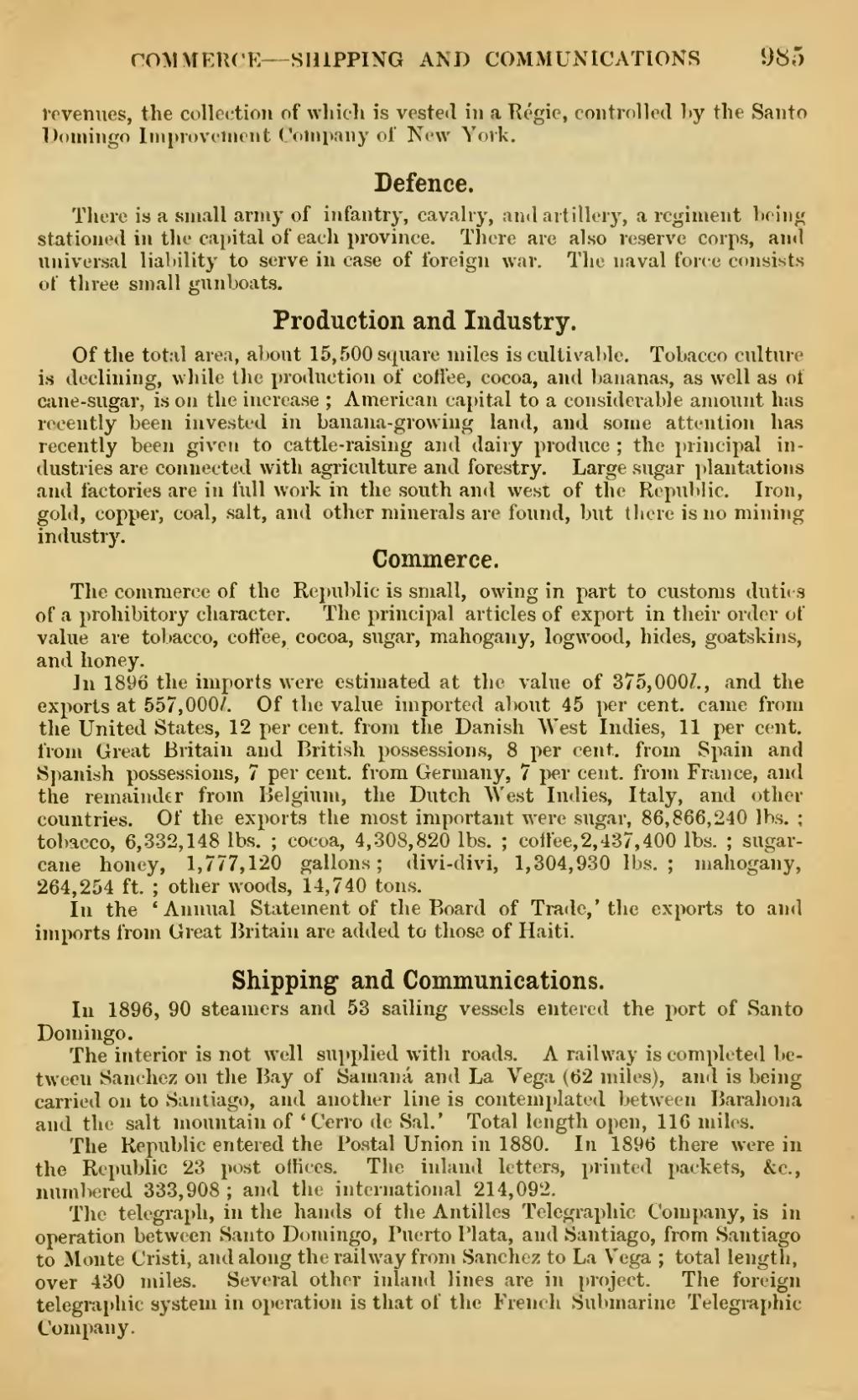rOMMEUCE — SHIPPING AND COMMUNICATIONS 985
vcvenues, the collection of which is vested in a Regie, controlled hy the Santo Domingo Improvement Company of New York.
Defence.
There is a small arm}* of infantry, cavalry, and artiller}', a regiment being stationed in the capital of each province. There are also reserve corps, and universal liability to serve in case of foreign war. The naval force consists of three small gunboats.
Production and Industry.
Of the total area, about 15, 500 square miles is cultivable. Tobacco culture is declining, while the production of coffee, cocoa, and bananas, as well as of cane-sugar, is on the increase ; American capital to a considerable amount has recently been invested in banana-growing land, and .some attention has recently been given to cattle-raising and dairy produce ; the principal in- dustries are connected with agriculture and forestry. Large sugar plantations and factories are in full work in the south and west of the Republic. Iron, gold, copper, coal, salt, and other minerals are found, but there is no mining industry.
Commerce.
The commerce of the Repulilic is small, owing in part to customs duties of a prohibitory character. The principal articles of export in their order of value are tobacco, coffee, cocoa, sugar, mahogany, logwood, hides, goatskins, and honey.
In 1896 the imports were estimated at the value of 375,000Z., and the exports at 557,000/. Of the value imported about 45 per cent, came from the United States, 12 per cent, from the Danish West Indies, 11 per cent, from Great Britain and British possessions, 8 per cent, from Spain and Spanish possessions, 7 per cent, from Germany. 7 per cent, from France, and the remainder from Belgium, the Dutch AVest Indies, Italy, and other countries. Of the exports the most important were sugar, 86,866,240 lbs. ; tobacco, 6,332,148 lbs. ; cocoa, 4,308,820 lbs. ; colfee,2,437,400 lbs. ; sugar- cane honey, 1,777,120 gallons; divi-divi, 1,304,930 lbs.; mahogany, 264,254 ft. ; other woods, 14,740 tons.
In the 'Annual Statement of the Board of Trade,' the exports to and imports from Great Britain are added to those of Haiti.
Shipping and Communications.
In 1896, 90 steamers and 53 sailing vessels entered the port of Santo Domingo.
The interior is not well supplied with roads. A railway is completed be- tween Sanchez on the Bay of Samana and La Vega (62 miles), and is being carried on to Santiago, and another line is contemplated between I5arahona and the salt mountain of ' Cerro de Sal.' Total length open, 116 miles.
The Republic entered the Postal Union in 1880. In 1896 there were in the Republic 23 post offices. The inland letters, printed packets, &c., nunibered 333,908 ; and the international 214,092.
The telegraph, in the hands of the Antilles Telegraphic Company, is in operation between Santo Domingo, Puerto Plata, and Santiago, from Santiago to Monte Cristi, and along the railway from Sanchez to La Vega ; total length, over 430 miles. Several other inland lines are in project. The foreign telegraphic system in operation is that of the French Submarine Telegraphic Company.
